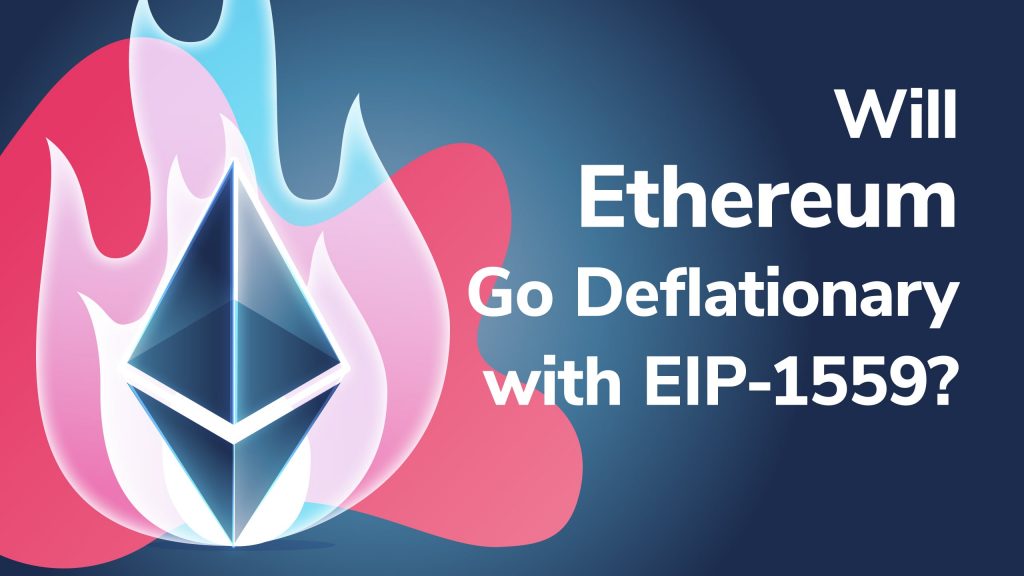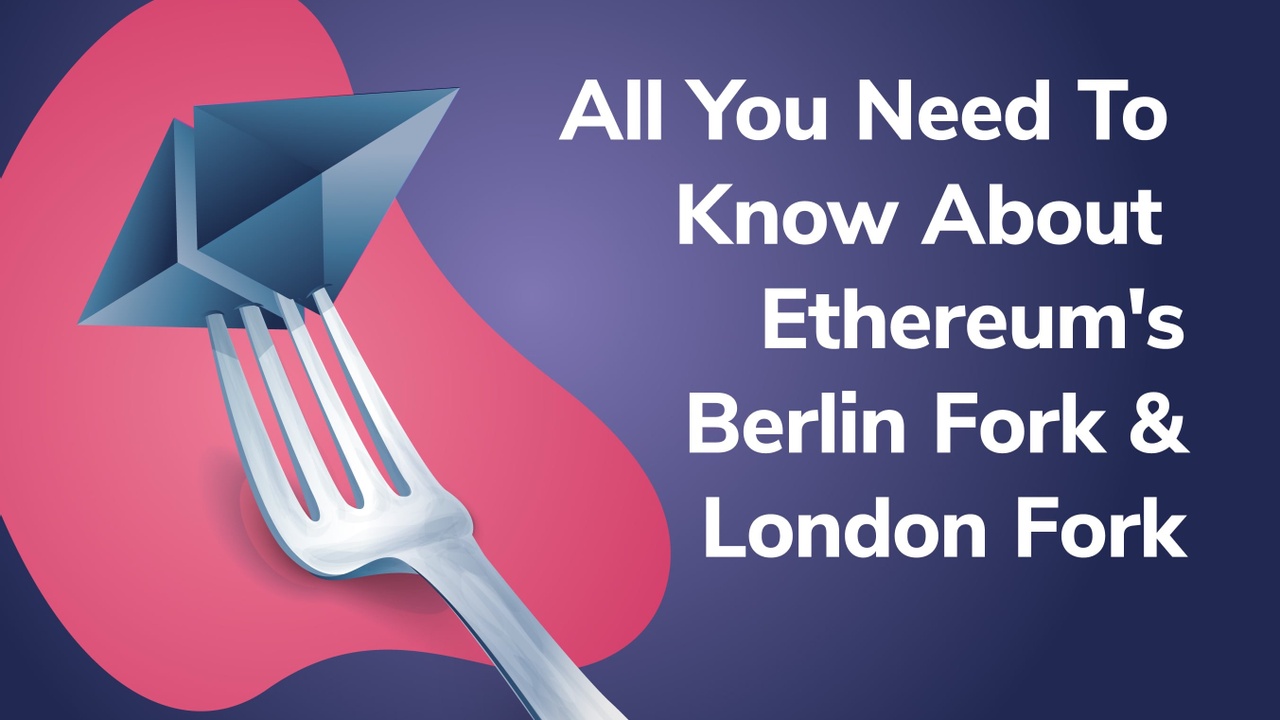
As the weeks roll by, we are getting closer to Ethereum’s major 2021 network upgrades. You may already have heard about either the Ethereum Berlin Hard Fork, scheduled for April, or the Ethereum London Hard Fork slated for July. In this article, we go through both of these Ethereum Network upgrades, along with the Ethereum Improvement Proposals (EIPs) that will be packaged with them. Read on for the ultimate guide to the Ethereum Berlin Hard Fork and the Ethereum London Hard Fork!
First of all, why do Ethereum network upgrades even matter? Well, those searching for the latest news on Ethereum or an Ethereum price prediction 2021 will likely have seen mentions of either Ethereum’s London fork or Ethereum’s Berlin fork, both scheduled for 2021. Although network upgrades like these are relatively technical, they can still be important for Ethereum fundamentals. So, what do the upcoming two Ethereum hard forks entail? In this article, we explain everything that’s packaged in the two forthcoming hard forks in an easily understood manner!
It has perhaps never been more important to keep an eye on the upcoming Ethereum network updates, with Ethereum recently reaching new all-time highs. Granted, Ethereum has not been the sole focus of the cryptocurrency sector in 2021. Roughly three months into the year, we’ve already witnessed a considerable Bitcoin bull run to roughly $60,000, as well as a surge of interest in NFT marketplaces such as Rarible and OpenSea. Moreover, 2021 has also seen the emergence of the Binance Smart Chain and a surge of interest in both BSC DeFi and BEP-20 tokens. This was largely precipitated by a massive increase in Ethereum gas fees. Enroll in Ivan on Tech Academy to understand all the latest crypto developments!
Ethereum Network Upgrades and EIPs
Ethereum Network upgrades are nothing new. Although we’re currently looking forward to the Ethereum Berlin Hard Fork later in April and the Ethereum London Hard Fork during the summer, these are nothing new. Long-time Ethereum followers will likely fondly remember historical Ethereum Network upgrades. For example, these include upgrades like the Ethereum Spurious Dragon, Ethereum Byzantium, Ethereum Constantinople, and the Ethereum St. Petersburg upgrades. In late 2019, the Ethereum Istanbul update was released, which was the last hard fork before Berlin. It was eventually followed by other notable updates during 2020, like that of the Ethereum Muir Glacier upgrade, the launch of the Medalla testnet, and the Ethereum 2.0 Beacon Chain.

Now, however, the Ethereum Network is about to get another two important upgrades. Within the coming months, the Ethereum Network will introduce both the Ethereum Berlin Hard Fork and the London Hard Fork. These non-backward compatible hard forks can be seen as stepping stones for the Ethereum Network on the way towards ”Serenity”, or Ethereum 2.0. We’ve previously discussed Ethereum 2.0 at length together with Ethereum’s move towards proof-of-stake rather than proof-of-work. However, although the full Ethereum 2.0 vision still remains some time off, very real improvements are being made to bring this vision to fruition.
Ethereum Network upgrades often package different so-called ”Ethereum Improvement Proposals”, or EIPs. To put it simply, Ethereum Improvement Proposals express e.g. standards for core Ethereum protocol specifications, contract standards, and client APIs. Anyone can suggest EIPs, and the community then decides on whether to adopt them. The upcoming pair of Ethereum Network upgrades take the form of hard forks, and they’ve gotten their names from the cities in which the Ethereum ”Devcon” developer conference took place. As such, the upcoming hard forks were named after Devcon0 in Berlin and Devcon1 in London, respectively.
What is the Ethereum Berlin Hard Fork?
Ethereum’s Berlin Hard Fork is the next upcoming update to the Ethereum Network. After being officially announced on March 8th, the Ethereum Foundation laid out the rough roadmap for how the Ethereum Berlin Hard Fork would become realized. Ropsten became the first testnet to upgrade on March 10th, the Goerli network followed on March 18th, and Rinkeby was slated for March 24th. Nevertheless, the Ethereum mainnet has not yet activated the Ethereum Berlin Hard Fork upgrade.

Instead, the Berlin Hard Fork will go live on the Ethereum mainnet with Block 12,244,000. Ethereum Block 12,244,000 is currently slated for April 15th, according to Etherscan’s Ethereum Block Countdown. Although all of the Ethereum Improvement Proposals (EIPs) included in the upcoming Berlin Hard Fork are relatively technical, we’ll do our best to break them down in an easily understood way. The different EIPs packaged with the Berlin Hard Fork address various issues, like modifications to Ethereum gas prices,
If you have more questions about the nature of the Ethereum Network or blockchain technology, don’t hesitate to enroll in some of the Ivan on Tech Academy blockchain courses. Ivan on Tech Academy offers industry-leading online courses and has a wealth of courses on Ethereum. If you’re new to cryptocurrency, be sure to take our Crypto Basics course. After that, you’ll be more than ready to take our basic Ethereum course and work your way up with our Ethereum Smart Contract Programming course, our advanced Ethereum Smart Contract Programming course to Ethereum Game Programming, Ethereum Smart Contract Security, and even Ethereum dApp Programming. Without any further ado, let’s dive into the Berlin Hard Fork’s four EIPs – EIP-2565, EIP-2718, EIP-2929, and EIP-2930!
EIP-2565 ”ModExp Gas Prices”
Ethereum’s EIP-2565 proposal is about a change to how gas prices are defined when it comes to ”modular exponentiation”. Modular exponentiation – more broadly known as ”ModExp” – is a discrete exponential function that is important for many cryptographic functions.

Today, however, Ethereum’s ModExp compiler is comparatively expensive, and EIP-2565 aims to make ModExp more usable in practice. EIP-2565 will attempt to do this by lowering gas prices for ModExp, and achieving strong randomness and security with e.g. VDFs (verifiable delay functions). Essentially, EIP-2565 will promote the use of a broader range of cryptographic operations for Ethereum smart contracts.
EIP-2718 ”Typed Transaction Envelope”
The EIP-2718 proposal, or the ”typed transaction envelope” proposal, aims to define a new transaction type. Specifically, this transaction type is planned to be an envelope for future Ethereum transaction types. So, what does this mean?

Well, essentially, EIP-2718 recognizes that new Ethereum transaction types are hard to add, seeing as these need to be backward compatible with other Ethereum transactions. EIP-2718 wants to solve this by introducing a sort of ”wrapper”, or envelope, for future transaction types.
EIP-2929 ”Gas Cost Increases for State Access Opcodes”
This Ethereum Improvement Proposal, which is co-authored by Vitalik Buterin and Martin Swende, also relates to gas prices much like EIP-2565. However, unlike how EIP-2565 lowers ModExp gas prices, EIP-2929 will instead increase certain gas costs. Specifically, operations (or ”opcodes”) that access memory have traditionally been cheap and have been involved in DoS attacks.

Although gas prices for opcodes have already been raised before, this has not sufficiently discouraged from these DoS attacks. The problem behind this is, according to EIP-2929, that it is still comparatively cheap for hackers to force all nodes to partake in this type of attack. EIP-2929 will increase the cost of state access opcodes roughly threefold, hopefully closing this vulnerability.
EIP-2930 ”Optional Access Lists”
The fourth and final EIP included in the Berlin hard fork is EIP-2930. According to the EIP’s ”simple summary”, EIP-2930 ”[a]dds a transaction type which contains an access list, a list of addresses and storage keys that the transaction plans to access. Accesses outside the list are possible but become more expensive”.

As such, this EIP will enable a new type of transaction where accessing inside the access list is cheaper. This new transaction type builds on EIP-2718 and introduces an asset list format to Ethereum. Furthermore, EIP-2930 also reduces risks of contract breakage otherwise introduced with EIP-2929.
What is the Ethereum London Hard Fork?
The Ethereum London Hard Fork, which is the next major hard fork following the Berlin hard fork, is set to go live ”around” July. Although this timeline could still change, signing the London hard fork in July of 2021 would mean that the testnets need to fork in June. What’s more, the fork needs to be essentially set in May, and the EIPs chosen for the Ethereum London Hard Fork will need to be tested and implemented during March and April of 2021.

According to the Ethereum Core Dev Meeting #107, which took place on March 5th, it’s likely that a total of six EIPs will be packaged into the Ethereum London Hard Fork. However, the only Ethereum Improvement Proposal that has been officially presented as a part of the Ethereum London Hard Fork so far is EIP-1559. Another potential feature that looks set to be included in the London hard fork is EIP-3238, resulting in something known as the Ethereum ”Difficulty Bomb Delay”.
EIP-1559 ”Fee Market Change for ETH 1.0 Chain”
Without a doubt, EIP-1559 is one of the most hotly debated Ethereum Improvement Proposals in recent history. We’ve previously covered this improvement proposal and whether or not this will make Ethereum deflationary. According to EIP-1559’s simple summary, EIP-1559 will contain a ”transaction pricing mechanism” that involves a fixed network fee which is burned, and which dynamically increases or reduces block sizes in order to combat network congestion.

You can read more about EIP-1559 in our dedicated article on the subject, but essentially, EIP-1559 could overhaul the user experience for gas management on Ethereum and introduce a ”BASEFEE” that depends on the current level of Ethereum network congestion. As such, the exorbitant Ethereum gas fees recently seen could be alleviated.
EIP-3238 ”Ethereum Difficulty Bomb Delay”
To understand EIP-3238, we first need to understand what the Ethereum ”Difficulty Bomb” is. The Ethereum Difficulty Bomb is a part of Ethereum that raises the difficulty level of Ethereum Proof of Work puzzles. As such, this would result in longer-than-normal block times, effectively cutting the current rate of ETH rewards for Ethereum miners.

Seeing as this mechanism increases the mining difficulty exponentially over time, it will eventually lead to something known as the ”Ethereum Ice Age”. This is when the Ethereum chain becomes so hard to mine that it becomes unattractive for miners to do so. In extension, the Ethereum Difficulty Bomb will likely encourage the switch to Ethereum 2.0. However, EIP-3238 delays the Ethereum difficulty bomb so that 30 second block times won’t occur until sometime around mid-2022.
What is the Ethereum Shanghai Hard Fork?
So, what’s next after the Ethereum London Hard Fork? Although this is still in the future and will likely come during the fall of 2021, there has been some talk about the next hard fork. Logic dictates that this next Ethereum Network upgrade should be called the ”Ethereum Shanghai Hard Fork”, named after Devcon2 which took place in Shanghai back in 2016. Although nothing is set in stone yet, the Ethereum Shanghai fork has been tentatively scheduled for October 2021.

Interestingly, some have speculated that this hard fork might not focus as much on features in the same way that the Berlin and London fork will. Instead, the Shanghai fork might revolve around the Ethereum 2.0 merge. However, this is still seemingly undecided, with some – most notably Ethereum Protocol Support expert Tim Beiko – arguing that the Shanghai fork will also be another ”regular” hard fork with more typical EIP features.
It remains to be seen whether the Ethereum Shanghai Hard Fork focuses on merging Ethereum and Ethereum 2.0. If it does, this will undoubtedly be one of the most important steps yet towards realizing the vision of Ethereum 2.0 Serenity. However, if that doesn’t come to pass, there is always the possibility of an Ethereum Cancún Hard Fork, named after Devcon3 in Cancún during 2017. Until then, however, the Berlin and London forks will likely bring enough news and debate to keep the Ethereum community occupied for some time going forward.





